03/22/2011 – The F-35 is the first combat aircraft that sees completely around itself, thanks to its Distributed Aperture System, a new sensor concept in air combat. All told, the F-35’s internal sensor suite can see hundreds of miles on a 360-degree basis. And, unlike legacy aircraft, which add systems that need to be managed by the pilot, the F-35’s core combat systems work interactively.

In this interview, Pete “Toes” Bartos of Northrop Grumman Electronic Systems, a former F-15/F-18 pilot and Joint Strike Fighter (JSF) requirements officer at the Air Combat Command, explains the nature of the F-35 combat systems and how they work together.
SLD: Could you give a sense of how the integration of a new generation of sensors really makes this a different aircraft? And describe the advantage of having a 360-degree capability.
Bartos: There are a couple components to the answer. It starts with the building blocks.
The Joint Strike Fighter was designed so that the different elements could be mutually supportive of each other. For example, the advanced electronically scanned array (AESA) radar and Electronic Warfare (EW) suite didn’t have to do everything by themselves; the Electrical Optical Targeting System (EOTS) and Distributed Aperture System (DAS) didn’t have to independently answer every infrared (IR) requirement. These sensors were designed to work together as a combat system with system level capabilities.
SLD: You were looking for interactive supportability?
Bartos: Absolutely. Fusion is the way to leverage the other sensors’ strengths. The sensor building blocks were designed to be flexible multi-function avionics that could reinforce the others.
Take the AESA radar as an example. We commonly refer to it as an MFA, a multi-function array. It has, of course, many air-to-air modes, and many air-to-ground modes. But it also offers capabilities as a fully capable EW aperture. For EW, I mean electronic protection, electronic attack, and electronic support, the latter of which involves sensing or passive ops.
The bottom line is the AESA design incorporated as much connectivity, processing and as wide a bandwidth as technology allowed in order to maximize flexibility and spectrum coverage.
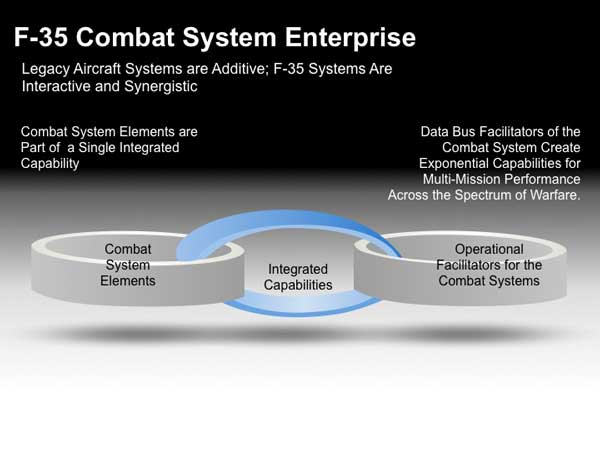 F-35 Combat System Enterprise (Credit: SLD)
F-35 Combat System Enterprise (Credit: SLD)
The radar interacts directly with the EW gear, which is imbedded on the F-35’s wing lines and other surfaces. The EW system gives you 360-degree coverage, and covers the radio frequency (RF) spectrum on the battlefield. The F-35 CNI system—communication, navigation and identification—is another flexible, reprogrammable system that further expands 360-degree RF spectrum coverage.
The radar and the EW system are symbiotic and are linked via a high-speed data bus built upon high-speed fiber optical systems. And the systems communicate virtually pulse-to-pulse to assist each other within the RF spectrum. So the radar can draw on advanced jamming resources, and the EW techniques can be channeled through the radar.
The AESA itself has its own attack modes as well and a very sensitive, precise geo-location capability, which can work in conjunction with EW gear. The CNI system is also linked via the high-speed data bus.
On the infrared side, you have DAS and EOTS. DAS was made sensitive enough, precise enough, and long-range enough to include aircraft detection and track capabilities. For even longer-range IR functions and targeting, EOTS can be used in conjunction with DAS.
Whether it’s detected passively via the EW system, DAS or EOTS, or whether the target is in the field of view of the multi-function radar, the F-35 can find it.
SLD: So you were looking for synergy among the systems, because you were designing from the ground up?
Bartos: The sensor systems are built to work together. I’ll focus primarily on the multi-functionality of the DAS and the AESA radar since both of these sensors were designed and built at Northrop Grumman.
DAS’ high-resolution sensors are used to provide missile warning, imagery, and as I’ve mentioned, aircraft detection. Since DAS tracks missiles at long range, it can see where the missiles came from as well as cue countermeasures. By slewing EOTS or the AESA to the launch point, you can identify the target and return fire. With the DAS visual mode, imagery is ported to the pilot’s helmet and over to the displays, and in the future perhaps even off board to other users.
A threat detection originating from the EW system could be instantly verified and refined with the radar, a DAS track, via EOTS or all four systems, depending on the geometry. A wingman’s sensors can add to the answer via the CNI system. The JSF mission fusion software has wide-ranging algorithms and the ability to task the various sensors to create and maintain target tracks and IDs.
In other words, you’ve got multiple tiers of capability.
SLD: Although designed for high-threat environments, in actual fact, the F-35 functions as a Swiss army knife able to operate throughout the spectrum of conflict?
Bartos: Yes, that’s the point. We find that we have tremendous flexibility built into the AESA radar and the DAS to address evolving mission needs.
Here’s an illustration of sensor flexibility. Northrop Grumman conducted a DAS test flight in June against a commercial space launch vehicle, a two-stage rocket. The DAS tracked the missile’s second stage for more than 800 miles. At the same time DAS also tracked aircraft all around our test jet, and even saw the re-entry of the rocket’s first stage. While DAS was never intended for ballistic missile defense missions, this flight test demonstrated that the capability already exists within the sensor.
We’re running down all sorts of threads right now with experiments and discovering multiple uses well outside the original intent of the DAS system
With the APG-81 radar, we’re currently testing advanced combat ID modes and identifying additional maritime uses as well.
SLD: This is an ID issue?
Bartos: An ID issue and a structural issue.
At the core of the F-35’s avionics capabilities is a very high-speed state-of-the-art processor, and there is a roadmap to continue advancing it. Every couple of years, every block or every two blocks at least, there’s a new generation of processor planned that fits right into the existing hardware and software architecture
When you have flexible avionics designs, like the F-35’s AESA, DAS, EW or EOTS, the sky is the limit on the number of applications you’ll want to incorporate, and you’ll need increased processor speeds for even more advanced modes
SLD: Does this mean that we can expect a significant growth path for data generated by the F-35 to support ground, maritime and distributed air operations?
Bartos: That is correct. The F-35 already has significant inherent capability, but the flexible sensor/fusion architecture can capitalize on the vast amounts of data generated by the F-35 to affordably meet new mission requirements. For example, right now in the baseline F-35, DAS is only tasked to provide air tracks and missile tracks, but we’re sure that will evolve. The moving targets, artillery, and other things DAS is also seeing and tracking could be integrated and reported simply by refining the DAS and fusion algorithms, and ensuring the processor capacity matches the data load.
SLD: Let us return to a point you made earlier. Could you highlight what you meant by the mental structure of a classic fighter versus the new approach?
Bartos: With a standard aircraft acquisition model, you’re going to have some static elements within the architecture—you’re going to build your core processor and you may integrate the radar. But then, somebody will come along and say, “Hey, I’ve got a great idea, let’s add a targeting pod.” So a podded sensor is added, but it is not integrated with the radar or any other add-ons.
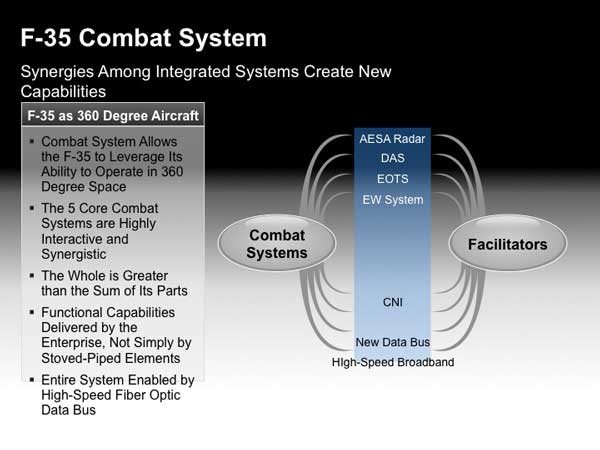 F35 Combat System Integration (Credit: SLD)
F35 Combat System Integration (Credit: SLD)
SLD: So, the difference would be the classic aircraft is an additive structure, whereas this is a flexible architecture that allows the F-35 to operate like a smart phone.
If I’ve got a traditional aircraft and I’m adding to it, there’s no interaction among the systems. The pilot would have to be looking at the displays and making the interaction happen. With the F-35, we’re describing a variety of tools that interact with one another so the pilot doesn’t have to spend a lot of time doing that.
Bartos: I think that’s a great summary. You’re not passing on raw data and making the pilot the integrator. You’re taking the sensor data from mutually supportive sensors, the architecture is integrating the data, and you’re presenting actionable information to the F-35 pilot.
During my combat missions over Iraq, the enemy was constantly shooting at me from the ground. I spent 90 percent of my time staring outside, scanning the ground and horizon for SAMs and anti-aircraft artillery, and 10 percent doing the F-15 air-to-air radar mission. That’s about all I could process.
The F-35 is going to do that scanning and processing for you, so you can determine how to most effectively employ or position the aircraft and create the battlefield effects you’re looking for.
In Iraq, it sure would have been better to have the aircraft just tell me if and when someone was shooting at me, from where, and with what type of weapon. Better still would be to have fed the threat coordinates directly to my weapons or offboard to my wingman to enable the immediate return of fire, like the F-35 will be able to do.
SLD: Could you explain the difference between the AESA system on the F-35 and a more conventional AESA?
Bartos: AESAs generally are distinguished by resolution, sensitivity, range and integration. The biggest hurdle to overcome is the ability of the radar to coexist and leverage the other RF systems, and the ability to do something with that RF data when it arrives. The APG-81 was built from the get-go for electronic warfare and for integration with other onboard EW systems.
The building blocks enable the APG-81 to outperform other radars, whether it be ID, electronic attack, electronic protection or stealthy operations. We’ve built in all these key features knowing that the F-35 is going to need to do much more than a traditional fighter. And these key features all have payback in the standard air-to-air and air-to-surface radar functions.
SLD: So we are talking about a combat system enterprise that allows you to start with the first F-35s and build out from the foundation?
Bartos: The core elements of the integrated enterprise are the AESA radar, the EW system, DAS, and the EOTS. But there are other key elements as well such as the CNI technology, the advanced processors, and the high-speed data bus using fiber optic transmission systems aboard the aircraft.
These enablers allow the synergistic capability to be crafted, enhanced, and communicated.
SLD: And this is a major shift from legacy aircraft?
Bartos: It’s akin to broadband versus dial-up modems. Yes, they both have Internet access, but non-integrated avionics are all doing dial-up because they’re stuck with a 1553 data bus and incompatible applications. In contrast, the F-35 has a brand new high-capacity data bus, along with integrated avionics.
Legacy aircraft can have additive tracks, but they’re not going to exploit multi-spectral data on a real-time basis the way the F-35 can.
SLD: As a former fighter pilot, you have much F-15 experience. How will pilots perform air-to-air operations differently with the F-35? It appears to be a big culture change.
Bartos: Well, it is. And without getting into all the tricks that the F-35 has up its sleeve, because you’re stealthy, you can get a lot closer to the adversary and your missile shots are now lethal, no-escape shots. With the F-15 today, you’re very wary of the range of the other guy’s missile, and you basically have to assume that he’s locked on to you, or at least knows where you are since you are in a big, non-stealthy airframe. And since you don’t have a missile warning system, you have to always assume that there is a missile headed your way when you get near an adversary.
You wind up playing this game of chicken, where you get close enough to throw a rock, and then you run away to avoid any rock coming back at you. And then you try to sneak back and throw another rock from a closer range. And then you run again and try to avoid his next rock. You hope he runs out of rocks first, or that he’s not looking when you throw one of your rocks. But you never get in there and throw rocks without the fear of retribution.
Like the F-22, the F-35 can maneuver right in there and attack with a close-in kill shot without playing chicken. If the F-35 gets in a bad situation, the pilot can extract himself a heck of a lot easier than in an F-15. The F-35 can turn away and still attack because it has eyes in the back of its head coupled with high off boresight missiles.
DAS is always tracking every aircraft nearby, in every direction, simultaneously, and looking for inbound missiles at the same time. F-35 mission fusion software keeps targets and IDs sorted out, even in a dynamic turning dogfight or when a target is directly behind you.
While flying an F-15 in a dogfight, I have to constantly swivel my head to manually detect and track adversaries and wingmen with my eyes. Situational awareness breaks down quickly, and I’m suddenly wondering if that distant object I’m looking at is an F-15 or an adversary aircraft.
I’ve flown against MiG-29s, and it wasn’t until I was up close and saw the paint job that I could be positive it wasn’t an F-15. With your head and eyes shifting back and forth under high G loading in a turning fight, it is very easy to lose sight, get confused, and misidentify aircraft.
Data link update rates are too slow for ID purposes in a dogfight. ID correlations frequently are swapped from wingmen to bandits and vice versa as they streak past your jet and swap sides.
The F-35 isn’t going to lose those IDs; it isn’t going to lose that situational awareness because there is always at least one sensor with high update rates tracking the various aircraft. In fact, you may even do better by just looking at your situational awareness displays or helmet symbology rather than at the confusing swirl of airplanes to visually sort out good from bad.
And if a missile is shot at you in the F-35, you’ll see it coming whether it is smokeless or not. You can take the appropriate measures, or just let the aircraft automatically provide the countermeasures.
In 95 percent of the air-to-air kills in history, the victim had no idea he was being shot at. Unless you’re referring to the other guy’s loss rate, that won’t be the case with the F-35.
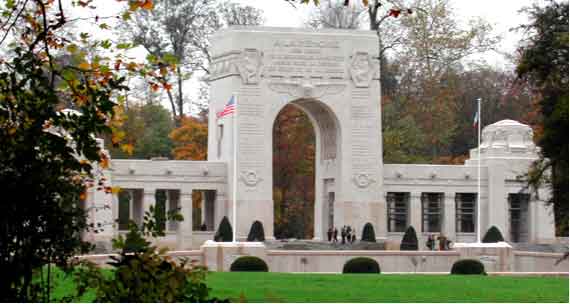 Memorial to the La Fayette Squadron (Credit: www.souvenir-francais-92.org)
Memorial to the La Fayette Squadron (Credit: www.souvenir-francais-92.org)





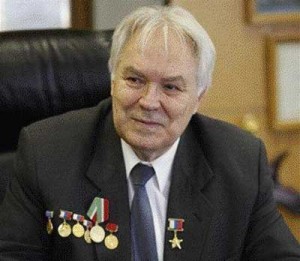
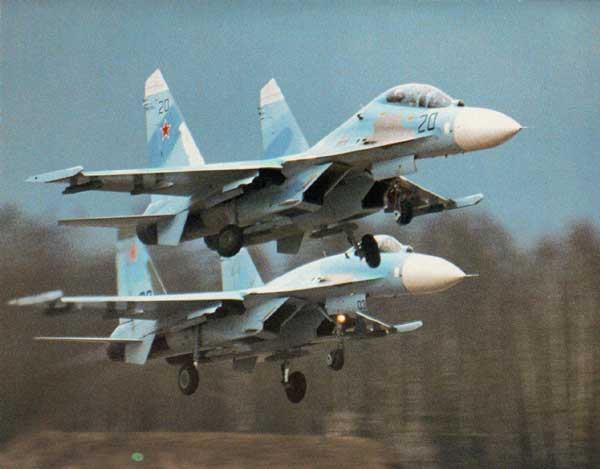
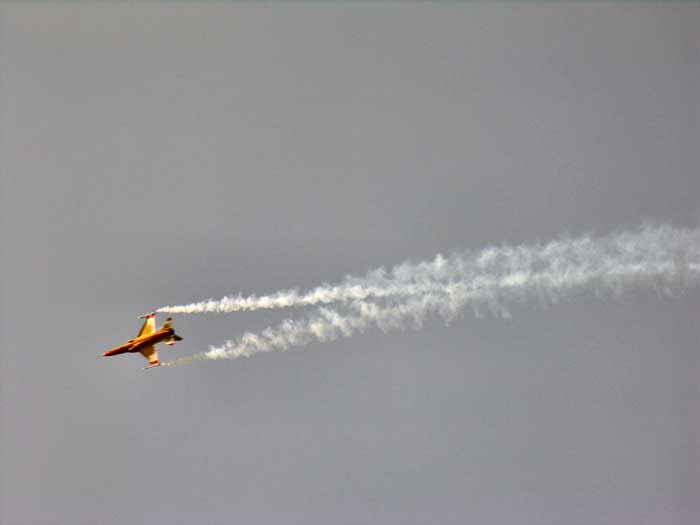

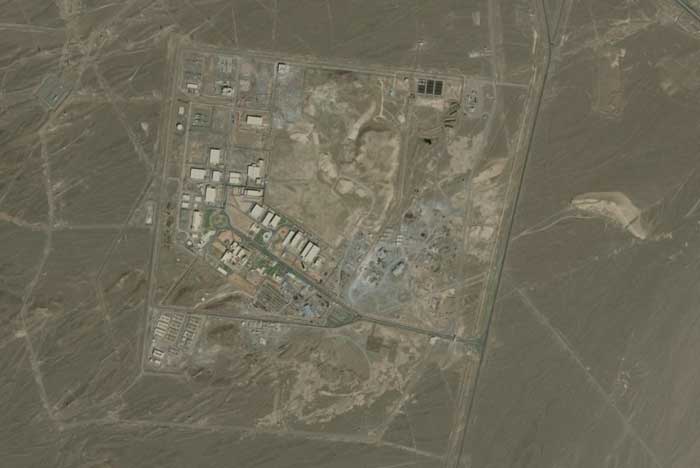


![10P00296_054[1]](https://www.sldinfo.com/wp-content/uploads/2011/03/10P00296_0541.gif)
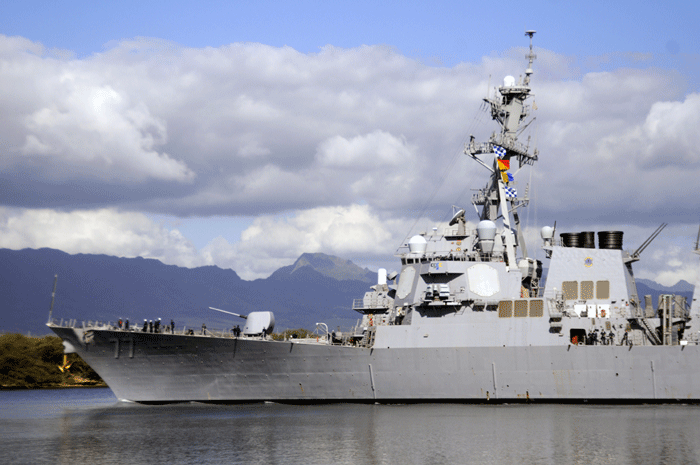 Photo Credit:
Photo Credit: 
 Photo Credit: 1st RCP, Jean-Marc Tanguy, Cahors, France, 2011
Photo Credit: 1st RCP, Jean-Marc Tanguy, Cahors, France, 2011

